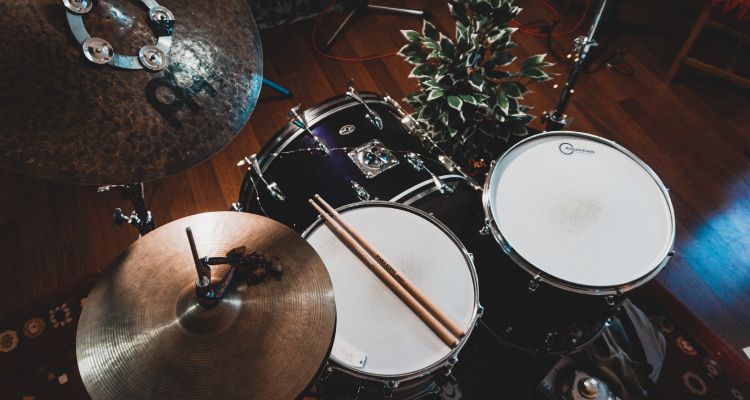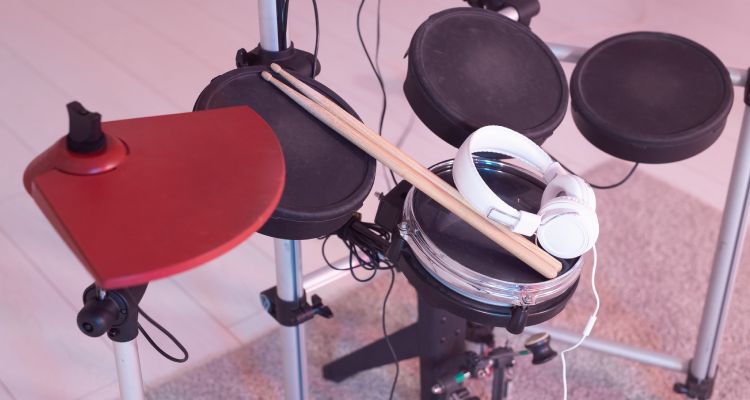One of the unfortunate things about a drum kit is that it tends to take up a lot of space. For drummers with wide and open rooms, this fact won’t affect them. For drummers with limited space in their living situation, this may potentially stop them from getting a drum set.
The last thing you want is to buy a new drum set that’s too big and doesn’t fit, or doesn’t allow you to move around the room in the way you want to.
The main two things to consider when you’re trying to figure out how much space a drum set will take up are the size of the drums themselves, and secondly the number of drums in the kit. Drum set dimensions differ according to what kind of drum kit you’re looking at.
This guide will detail everything you need to consider when looking to buy a drum set for your living space. I’ll explain how big different drum sets are, and how much room you’ll need available. I’ll also give a few tips for saving space with your drum kit setup.
Contents
How Much Floor Space is Needed for a Drum Set?
The amount of floor space you need for a drum set depends on what kind of drum set you have, but you’ll need a minimum space of roughly 75” x 55” for an average five-piece drum set. (177cm x 127cm)
If you are looking to buy a compact drum kit or beginner electronic drum set, you can afford to have less space, of approximately 40” x 40” to accommodate either of these.
Different Drum Kit Dimensions
Standard Drum Kit Sizes
Drum sets can drastically range in size from very small compact drum sets to large double bass drum sets. The most common size for a drum set is a five-piece set, which includes a bass drum, two tom-toms, a floor tom, and a snare drum.
If you’re just starting out, you’ll typically be looking at a standard five-piece drum set, which will also include a standard cymbal setup of a pair of hi-hats, a crash cymbal, and a ride cymbal.
Here are the sizes to expect with that setup:
- Snare drums – 14” x 5” – 8”
- High toms – 10” x 6” – 8”
- Middle toms – 12” x 8” – 10”
- Floor toms – 16” x 12” – 16”
- Bass drums – 20” or 22” x 14” – 18”
Standard drum kits will typically have a single pair of hi-hats, two crash cymbals, and a ride cymbal. While those cymbals differ in size, the placement of the stands holding them is what will actually affect the footprint of the entire drum kit.
When setting up a standard drum set, the average footprint will be around 75” x 55”.
Compact Drum Kit Sizes

Compact drum kits are ideal options for saving space. These sets are designed to be played the same way as standard sets, but they’re a lot smaller. They have fewer drums to play, and their shell dimensions are smaller in most cases.
Here are the sizes to expect from a compact drum kit:
- Snare drums – 10” – 14” x 5” or 6”
- Rack toms – 6” – 10” x 4” – 8”
- Floor toms – 12” – 14” x 8” – 14”
- Bass drums – 14” – 20” x 10” – 14”
No compact drum sets come with middle toms, so you can move the ride cymbal stand closer to the bass drum when setting these up. That tends to save a lot of space.
Some compact sets are naturally a lot larger than others, but the general footprint to expect will be around 60” x 55”.
Larger Drum Kit Sizes
If you want to have several toms and cymbals within your drum set setup, the drum set size will be much larger than what we saw with a standard 5-piece set.
It’s common for drummers to use 7-piece sets that have one extra rack tom and one extra floor tom. That kind of setup would be slightly larger than a 5-piece, taking up a wider area to accommodate those extra toms.
Some drummers take it to the next level, having enormous drum kits that take up more space than an SUV. It’s common to see metal drummers with setups containing ten toms and a dozen cymbals. They also often have two bass drums.
It’s a bit harder to tell how much space an extended drum kit will take up. It all depends on how much you want to add to it. A general idea of a footprint would be around 100” x 70”.
Electronic Drum Kit Sizes

Drum kit size with electronic drum kits differs depending on how big the electronic pads are for the drums and cymbals.
One of the biggest benefits of using electronic drum kits, apart from the lowered volume, is that their footprints are a lot smaller than what you get with an acoustic kit. So, you don’t need as much floor space.
With beginner and intermediate electronic drum kits, the drum pads are all connected to a single rack. This makes it very easy to fit those kits into small spaces, and you’ll often find beginner drummers gravitating toward these because of that.
A higher-priced electronic drum set will be a bit larger, and many of them have similar drum sizes to what you’ll find on any standard acoustic drum kit.
Electronic drums also get paired with a sound module, and that takes up a bit of space on the side of a kit.
So, an average footprint for a beginner or intermediate electronic drum kit is 45” x 50”, and an average footprint for a top-tier e-kit is 60” x 50”.
How to Save Space When Setting Up a Drum Set
Mounted Rack Toms
Some drum sets have toms that mount to the bass drum (known as a drilled bass drum), while others have toms that need to attach to cymbal stands. If you want to save space, you should buy a drum set that has toms that mount to the bass drum.
This will stop you from having to position your cymbal stands in certain ways to make the toms sit comfortably. You then don’t need to rely on using cymbal stands, giving you more freedom to place your hardware in various ways.
Attachable Cymbal Arms
If you want to have more cymbals in your setup, consider getting attachable cymbal arms instead of full stands. You can latch these onto your current stands, and then you can angle them so that the attached cymbal is in a comfortable position.
This will keep the footprint size of your kit down, as you won’t have extra legs from a stand to worry about. You just need to make sure that the cymbal stands you’re attaching the arms to are stable enough to hold extra weight comfortably.
Cut Down on Cymbals and Drums On Your Drum Set
The fewer drums and cymbals you have in your setup, the less space the kit will take up. If you’re limited on space, you should aim to have a drum setup that only has the essentials.
A common setup that drummers use when playing gigs is to only have a single rack tom. Without a middle rack tom, you can move the ride closer to take up less overall space. You could then get a ride cymbal that has good crashability. This will eliminate the need for a second crash cymbal and stand.
Having one rack tom and one floor tom is enough for most drum parts in songs.
This method won’t work as well on an electronic drum set, as all the drums and cymbals are attached to a rack anyway.
Get a Drum Rug

Getting a drum rug is a great way to designate floor space and separate a section of a room for drums. Drum rugs are designed to accommodate the general footprint of a drum set, so having one of those will guarantee that you’ll have enough space for a standard set.
Drum rugs also work excellently for both acoustic and electronic drum kits.
How Much Space Does a Stacked Drum Set Take Up?
Stacked drum sets take up far less space, and you can easily fit them in a corner. The footprint of a stacked drum kit will be whatever the size is of the kick drum of that set, as that will be resting at the bottom of the stack.
If you’re thinking of standard acoustic drum kits, you’ll need to have an average floor space of 22” x 22” freely available. If your bass drum is smaller than 22” for a compact drum kit, then you’ll need less with the average floor space.
Conclusion
So, how big is a drum set, and how much space do you need? It all depends on how big your setup is. To give a brief recap, a standard 5-piece drum kit needs about 75” x 55” of free space. A compact kit needs about 60” x 55” of free space.
An electronic drum kit needs about 45” x 60” if it’s a beginner or intermediate kit. A higher-quality electronic drum kit needs about 60” x 50”.
The floor space needed for a kit can often be assumed according to how big the bass drum is. The larger the bass drum, the more space you’ll need. When comparing electronic and acoustic drums, it’s important to remember that acoustic drum kits take up more space than electronic drum sets.









